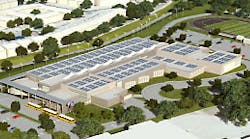They say everything is bigger in Texas, and Lady Bird Johnson Middle School will most certainly support this claim when it opens its doors next summer. Upon completion, the $29-million, 150,000-sq-ft K-12 facility, which is part of the Irving, Texas, Independent School District, will hold the distinction of being not only the largest net-zero public middle school in the United States, but also the first school of its kind in Texas.
For those not familiar with the term net-zero, the concept is relatively simple: a building that is designed to produce as much energy as it consumes through use of efficient technologies and on-site power generation.
Solar panels, wind turbines, and geothermal wells comprise the three types of renewable energy that Lady Bird Johnson Middle School will employ to generate power.
“The main source of power will come from solar panels installed on the building’s roof, with supplemental electricity produced by the facility’s 12 on-site wind turbines, which have been sized to fit on the school’s property,” explains Charles E. DeVoe III, president of Dallas-based Charter Builders, a subsidiary of Balfour Beatty Construction and the project’s general contractor. “Furthermore, a geothermal well system that taps into the Earth’s natural energy will operate the HVAC system at a reduced cost and supply hot water throughout the building.”
To help keep the school at net-zero status, numerous other energy-efficient elements are being incorporated into the building, including daylight harvesting, occupancy sensors, lighting dimmers, the use of low-e glass in windows, light shelves that will reflect daylight into the space and offer shading during summer months, laptop computers with wireless networking to reduce the plug-in load, and insulated concrete panels for the exterior walls and roof.
“A state-of-the-art integrated energy management system will control the building’s lights, HVAC system, and monitor energy usage 24/7, automatically adjusting levels as needed,” says Mark Mitchell, division manager for Austin, Texas-headquartered Facility Solutions Group (FSG), the project’s electrical subcontractor.
In addition to making this project unique for FSG and Charter Builders, these renewable power sources and advanced energy-saving technologies have presented both contractors with unforeseen rewards and challenges. On the plus side, they will help Lady Bird Johnson Middle School easily attain LEED Gold certification. However, they also initially posed a slight challenge for the contractors.
“We’ve had to spend probably several hundred hours learning the ins and outs of the solar and energy management system installations to ensure everything is done correctly,” Mitchell says.
DeVoe concurs. “Our core business focus is education, with an emphasis on K-12 projects,” he notes. “Solar panels, wind turbines, and geothermal wells are elements we typically don’t encounter. This meant that prior to the construction phase of this project we had to educate ourselves about these renewable technologies to ensure we understood their manufacturing and installation processes to avoid possible delays.”
To further reduce the potential for construction delays and conflicts between trades, Charter Builders used building information modeling (BIM) in the pre-design process, which DeVoe says gives his company an edge over some of its competitors and also helps increase offsite productivity, reduce safety hazards, and stay on schedule.
“Another exciting aspect of this project is that the building itself will serve as an extended classroom,” observes DeVoe. “The school contains areas that will allow students to actually see some of these systems at work, such as the solar panels and geothermic HVAC. They’ll also be able to view parts of a rainwater collection system and participate in recycling. A whole generation of children will learn what it takes to be environmentally responsible.”
Slated for completion in July 2011, the project is expected to finish on schedule, and Lady Bird Johnson Middle School will welcome its first students next fall.



